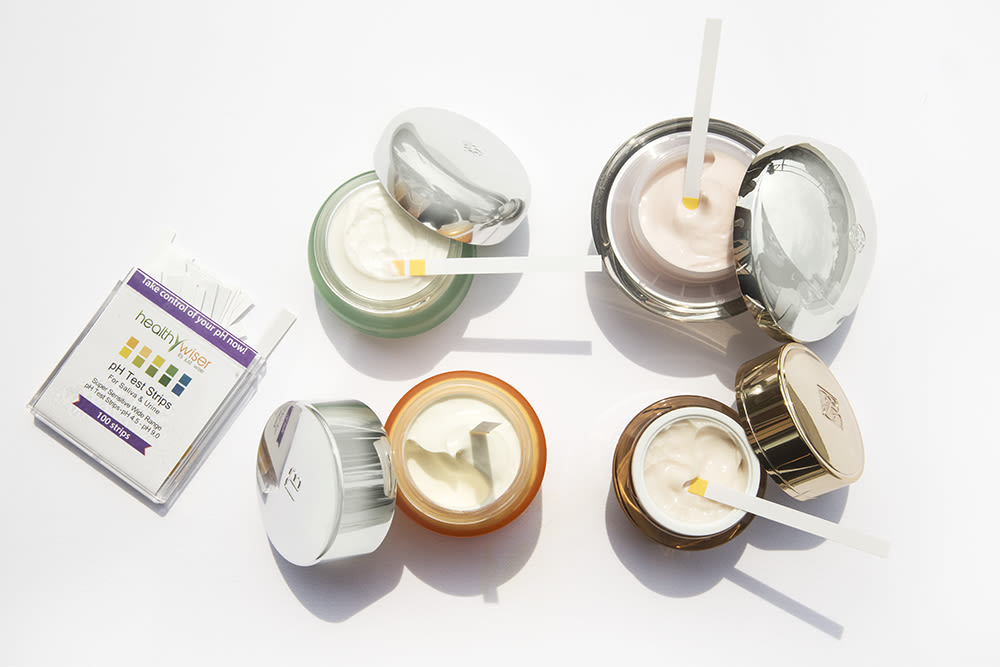While acid mantle might sound like some kind of mind-altering cloak placed upon the shoulders of an aging psych-pop front man, the reality is that everybody’s got one going on—right on their very faces, in fact. But what exactly does that mean? And is there anything to do about it?
Well, like its name implies, it’s a film of amino/lactic acids and oils protecting skin from environmental factors (bacteria, pollutants) that contribute to premature aging and irritation. The relative success or failure of your own personal acid mantel depends upon its pH level (the real reason to write this). This is where your remnants of high school chemistry come back into play. A refresher: The pH scale measures hydrogen concentration at a range of one to 14; anything over seven is considered alkaline (or basic, though not in the “bitch” sense of the word). Skin that falls on this end of the scale tends to be drier and potentially more susceptible to wrinkles. While somewhat less common, skin that’s too acidic will often appear red, irritated, and is more prone to breakouts. Just right skin, Goldilocks? This will register only slightly acidic, around 5.5, while conjuring desirable adjectives such as “plump” and “glowing.” It’s the epidermal sweet spot, so to speak.
For the most part, you can determine the pH level of your own skin by its behavior; again, dry/fragile probably means it’s alkaline while irritated, and acne-prone means it’s overly acidic. But if you’re the objective type and more swayed by concrete evidence, pH testing strips like those offered by pHion can gauge a body’s general pH. Ultimately, consulting your dermatologist will give you the most accurate reading where skin is concerned.
It never hurts to remember that your body is a system, and the things you put inside it affect the way it looks on the outside. To this end, a produce-happy diet can help balance your skin’s pH. As far as external treatments go, it’s good to be mindful of formulas and ingredients. I spoke recently with Dr. Miriam Hanson of Sanova Dermatology in Austin about how to reach equilibrium with your complexion. “To maintain a healthy balance in the skin, it’s best to avoid harsh soaps that have an alkaline pH and instead use neutral or slightly acidic soaps with alpha or beta hydroxy acids,” she says.
The “harsh soaps” Dr. Hanson references here include many bar soap varieties which boast an alkalinity well over nine. Though they might help you feel squeaky-clean, they can also really dry you out—just consider the residual itchy tightness that often comes after lathering up with Ivory or Irish Spring. To be kinder to your acid mantle, especially on your face, consider oil or gel-based cleansers such as Josie Maran’s Argan Cleansing Oil or Phace Bioactive’s Detoxifying Gel Cleanser (this line specializes in pH balancing formulas). Toners are also healthy pH promoters; good options include Perricone MD Firming Facial Toner, Origins' United State Balancing Tonic, and Neutrogena’s Pore Refining Toner. Peels can’t hurt either, so long as you don’t overdo it; Ole Henriksen’s Lemon Strip Flash Peel and the beloved Alpha Beta Peel from Dr. Dennis Gross both have legions of fans to recommend them.
While all this information is useful, if your skin’s going truly haywire, it’s probably best not to play amateur chemist; instead, consider seeking out the help/advice of a skincare professional. But for those just trying to treat their skin right, proper pH is really nothing more than a balancing act.
—Lauren Maas
Photographed by Tom Newton. Now you know that your oily skin means your overly acidic, so here's what you should be using.

